Business Model Canvas for Afterpay.
VerifiedAdded on 2022/08/29
|10
|2420
|19
AI Summary
Contribute Materials
Your contribution can guide someone’s learning journey. Share your
documents today.
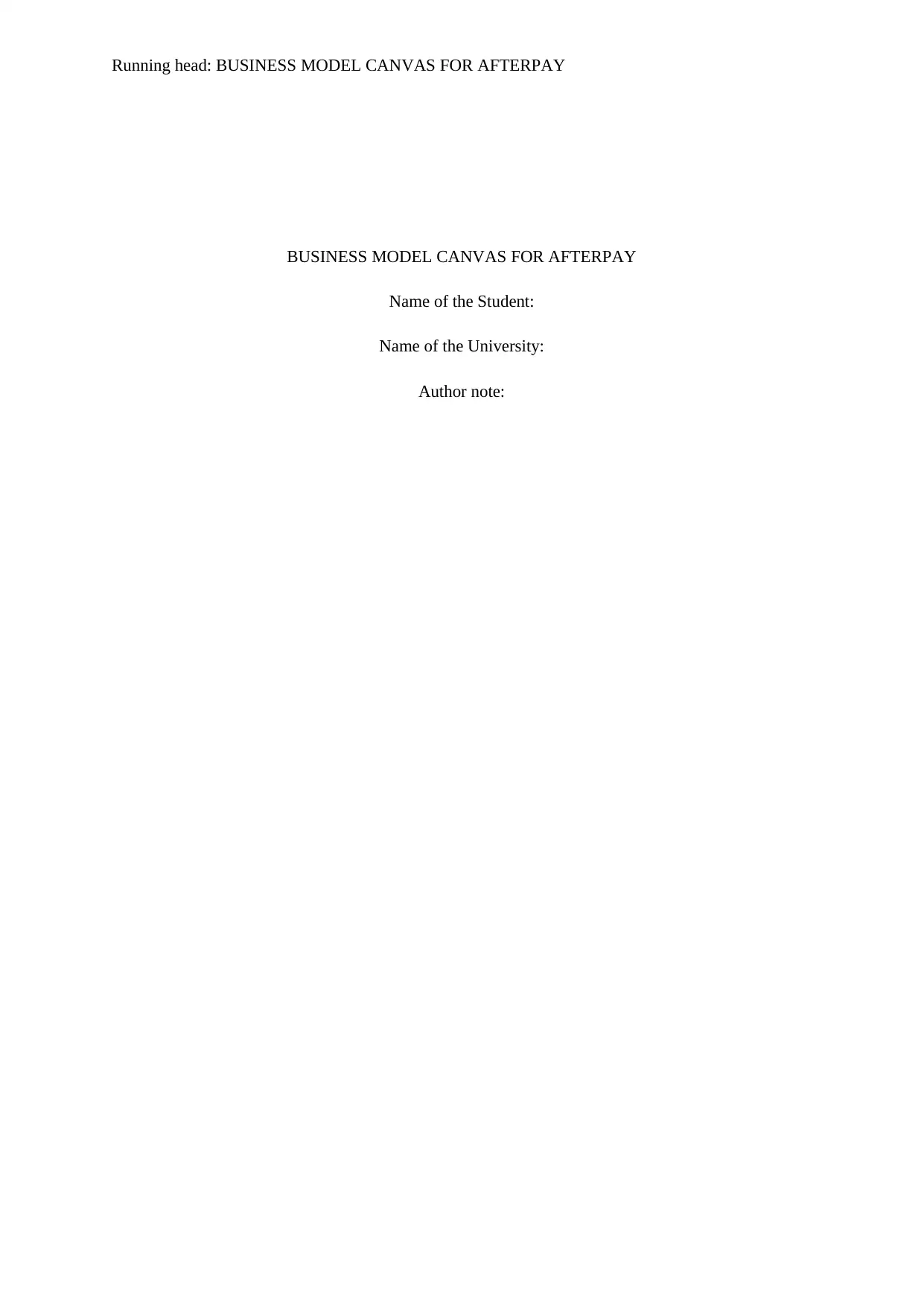
Running head: BUSINESS MODEL CANVAS FOR AFTERPAY
BUSINESS MODEL CANVAS FOR AFTERPAY
Name of the Student:
Name of the University:
Author note:
BUSINESS MODEL CANVAS FOR AFTERPAY
Name of the Student:
Name of the University:
Author note:
Secure Best Marks with AI Grader
Need help grading? Try our AI Grader for instant feedback on your assignments.

1BUSINESS MODEL CANVAS FOR AFTERPAY
Executive Summary
The chosen organisation for this business report is Afterpay, a successful firm that is engaged in
technology driven payments. In other words, it provides digital services related to payments of
products and services in instalment that is divided into 14 days. The firm has gained a good popularity
among the Australians within very short period of time. This report has elaborated on presenting the
business model of Afterpay using all the nine components of Business Model Canvas approach
described by Osterwlder & Pignuer’s. The company can improve its business processes and
operations following the suggested recommendations of strengthening its process of business
development, investing more in technology and in new products and by expanding its product and
service offerings.
Executive Summary
The chosen organisation for this business report is Afterpay, a successful firm that is engaged in
technology driven payments. In other words, it provides digital services related to payments of
products and services in instalment that is divided into 14 days. The firm has gained a good popularity
among the Australians within very short period of time. This report has elaborated on presenting the
business model of Afterpay using all the nine components of Business Model Canvas approach
described by Osterwlder & Pignuer’s. The company can improve its business processes and
operations following the suggested recommendations of strengthening its process of business
development, investing more in technology and in new products and by expanding its product and
service offerings.
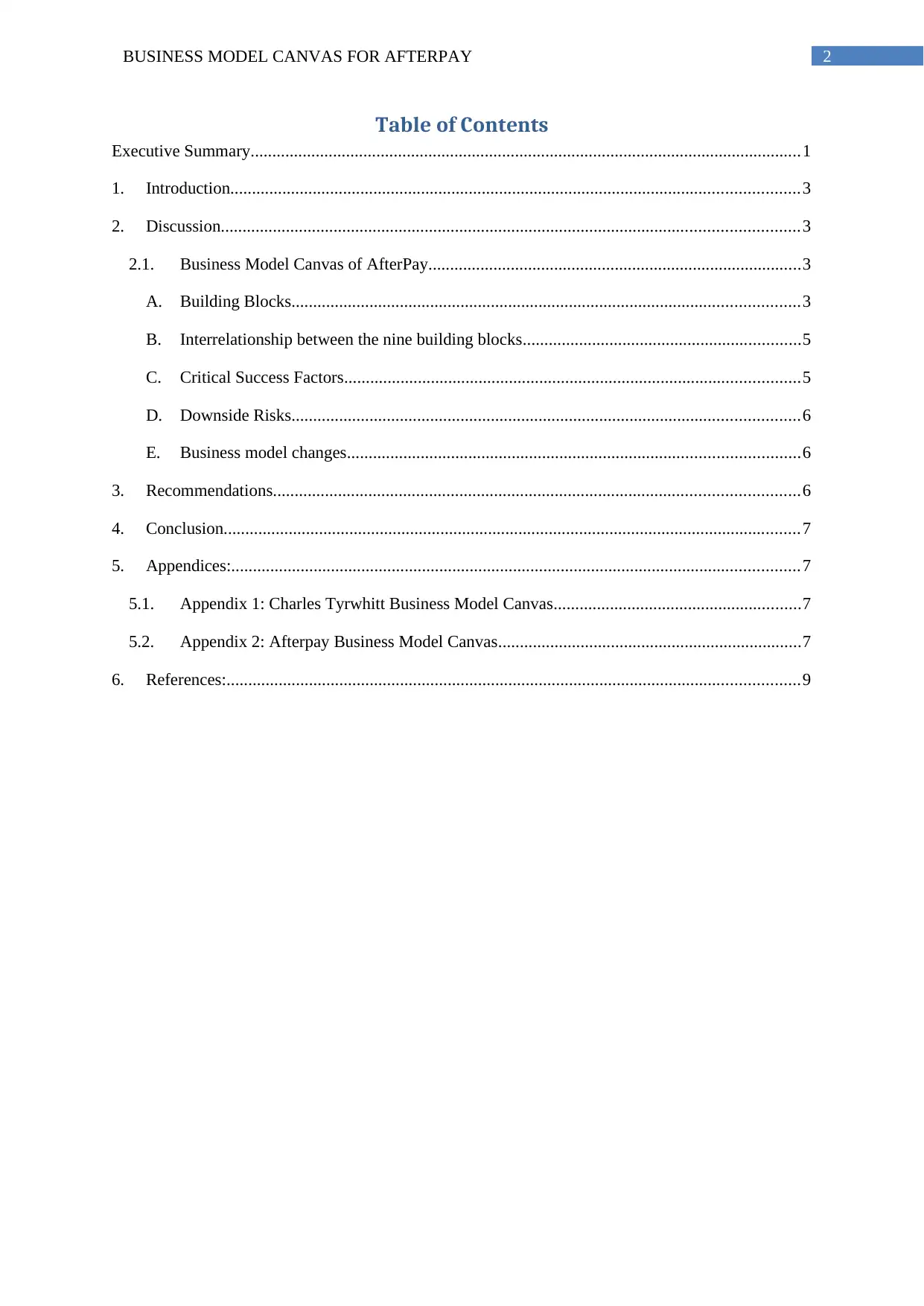
2BUSINESS MODEL CANVAS FOR AFTERPAY
Table of Contents
Executive Summary...............................................................................................................................1
1. Introduction...................................................................................................................................3
2. Discussion.....................................................................................................................................3
2.1. Business Model Canvas of AfterPay......................................................................................3
A. Building Blocks.....................................................................................................................3
B. Interrelationship between the nine building blocks................................................................5
C. Critical Success Factors.........................................................................................................5
D. Downside Risks.....................................................................................................................6
E. Business model changes........................................................................................................6
3. Recommendations.........................................................................................................................6
4. Conclusion.....................................................................................................................................7
5. Appendices:...................................................................................................................................7
5.1. Appendix 1: Charles Tyrwhitt Business Model Canvas.........................................................7
5.2. Appendix 2: Afterpay Business Model Canvas......................................................................7
6. References:....................................................................................................................................9
Table of Contents
Executive Summary...............................................................................................................................1
1. Introduction...................................................................................................................................3
2. Discussion.....................................................................................................................................3
2.1. Business Model Canvas of AfterPay......................................................................................3
A. Building Blocks.....................................................................................................................3
B. Interrelationship between the nine building blocks................................................................5
C. Critical Success Factors.........................................................................................................5
D. Downside Risks.....................................................................................................................6
E. Business model changes........................................................................................................6
3. Recommendations.........................................................................................................................6
4. Conclusion.....................................................................................................................................7
5. Appendices:...................................................................................................................................7
5.1. Appendix 1: Charles Tyrwhitt Business Model Canvas.........................................................7
5.2. Appendix 2: Afterpay Business Model Canvas......................................................................7
6. References:....................................................................................................................................9
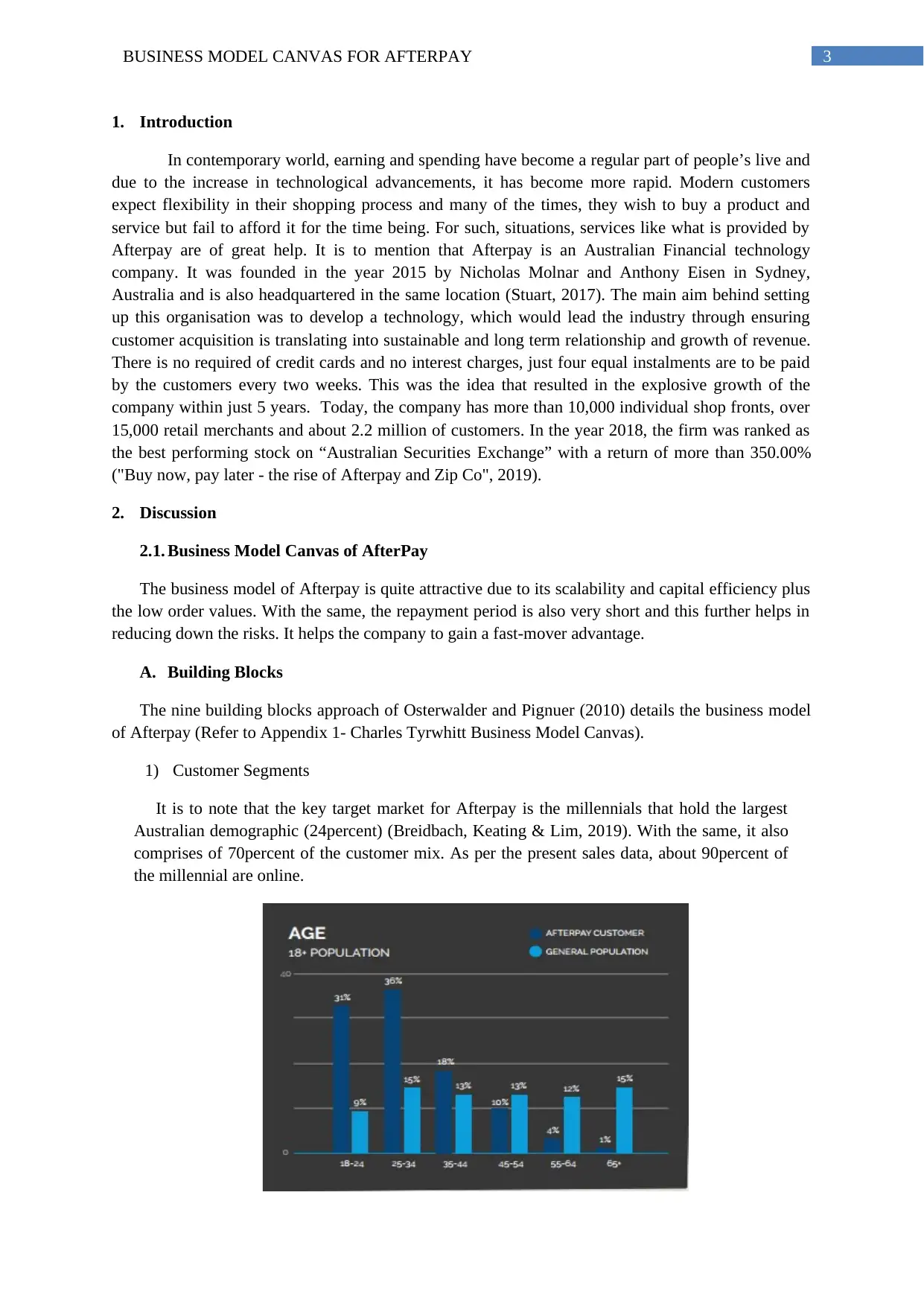
3BUSINESS MODEL CANVAS FOR AFTERPAY
1. Introduction
In contemporary world, earning and spending have become a regular part of people’s live and
due to the increase in technological advancements, it has become more rapid. Modern customers
expect flexibility in their shopping process and many of the times, they wish to buy a product and
service but fail to afford it for the time being. For such, situations, services like what is provided by
Afterpay are of great help. It is to mention that Afterpay is an Australian Financial technology
company. It was founded in the year 2015 by Nicholas Molnar and Anthony Eisen in Sydney,
Australia and is also headquartered in the same location (Stuart, 2017). The main aim behind setting
up this organisation was to develop a technology, which would lead the industry through ensuring
customer acquisition is translating into sustainable and long term relationship and growth of revenue.
There is no required of credit cards and no interest charges, just four equal instalments are to be paid
by the customers every two weeks. This was the idea that resulted in the explosive growth of the
company within just 5 years. Today, the company has more than 10,000 individual shop fronts, over
15,000 retail merchants and about 2.2 million of customers. In the year 2018, the firm was ranked as
the best performing stock on “Australian Securities Exchange” with a return of more than 350.00%
("Buy now, pay later - the rise of Afterpay and Zip Co", 2019).
2. Discussion
2.1. Business Model Canvas of AfterPay
The business model of Afterpay is quite attractive due to its scalability and capital efficiency plus
the low order values. With the same, the repayment period is also very short and this further helps in
reducing down the risks. It helps the company to gain a fast-mover advantage.
A. Building Blocks
The nine building blocks approach of Osterwalder and Pignuer (2010) details the business model
of Afterpay (Refer to Appendix 1- Charles Tyrwhitt Business Model Canvas).
1) Customer Segments
It is to note that the key target market for Afterpay is the millennials that hold the largest
Australian demographic (24percent) (Breidbach, Keating & Lim, 2019). With the same, it also
comprises of 70percent of the customer mix. As per the present sales data, about 90percent of
the millennial are online.
1. Introduction
In contemporary world, earning and spending have become a regular part of people’s live and
due to the increase in technological advancements, it has become more rapid. Modern customers
expect flexibility in their shopping process and many of the times, they wish to buy a product and
service but fail to afford it for the time being. For such, situations, services like what is provided by
Afterpay are of great help. It is to mention that Afterpay is an Australian Financial technology
company. It was founded in the year 2015 by Nicholas Molnar and Anthony Eisen in Sydney,
Australia and is also headquartered in the same location (Stuart, 2017). The main aim behind setting
up this organisation was to develop a technology, which would lead the industry through ensuring
customer acquisition is translating into sustainable and long term relationship and growth of revenue.
There is no required of credit cards and no interest charges, just four equal instalments are to be paid
by the customers every two weeks. This was the idea that resulted in the explosive growth of the
company within just 5 years. Today, the company has more than 10,000 individual shop fronts, over
15,000 retail merchants and about 2.2 million of customers. In the year 2018, the firm was ranked as
the best performing stock on “Australian Securities Exchange” with a return of more than 350.00%
("Buy now, pay later - the rise of Afterpay and Zip Co", 2019).
2. Discussion
2.1. Business Model Canvas of AfterPay
The business model of Afterpay is quite attractive due to its scalability and capital efficiency plus
the low order values. With the same, the repayment period is also very short and this further helps in
reducing down the risks. It helps the company to gain a fast-mover advantage.
A. Building Blocks
The nine building blocks approach of Osterwalder and Pignuer (2010) details the business model
of Afterpay (Refer to Appendix 1- Charles Tyrwhitt Business Model Canvas).
1) Customer Segments
It is to note that the key target market for Afterpay is the millennials that hold the largest
Australian demographic (24percent) (Breidbach, Keating & Lim, 2019). With the same, it also
comprises of 70percent of the customer mix. As per the present sales data, about 90percent of
the millennial are online.
Secure Best Marks with AI Grader
Need help grading? Try our AI Grader for instant feedback on your assignments.
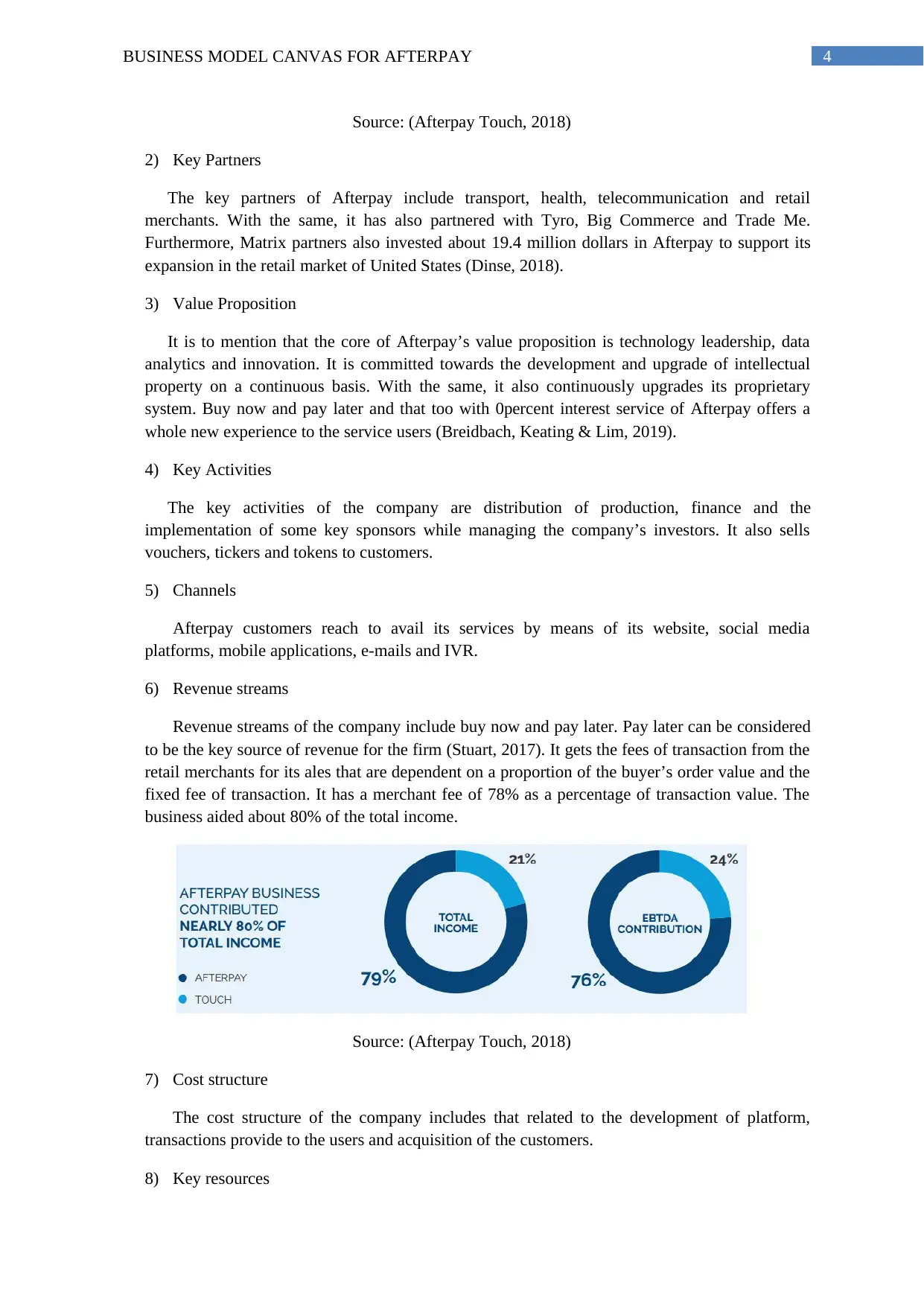
4BUSINESS MODEL CANVAS FOR AFTERPAY
Source: (Afterpay Touch, 2018)
2) Key Partners
The key partners of Afterpay include transport, health, telecommunication and retail
merchants. With the same, it has also partnered with Tyro, Big Commerce and Trade Me.
Furthermore, Matrix partners also invested about 19.4 million dollars in Afterpay to support its
expansion in the retail market of United States (Dinse, 2018).
3) Value Proposition
It is to mention that the core of Afterpay’s value proposition is technology leadership, data
analytics and innovation. It is committed towards the development and upgrade of intellectual
property on a continuous basis. With the same, it also continuously upgrades its proprietary
system. Buy now and pay later and that too with 0percent interest service of Afterpay offers a
whole new experience to the service users (Breidbach, Keating & Lim, 2019).
4) Key Activities
The key activities of the company are distribution of production, finance and the
implementation of some key sponsors while managing the company’s investors. It also sells
vouchers, tickers and tokens to customers.
5) Channels
Afterpay customers reach to avail its services by means of its website, social media
platforms, mobile applications, e-mails and IVR.
6) Revenue streams
Revenue streams of the company include buy now and pay later. Pay later can be considered
to be the key source of revenue for the firm (Stuart, 2017). It gets the fees of transaction from the
retail merchants for its ales that are dependent on a proportion of the buyer’s order value and the
fixed fee of transaction. It has a merchant fee of 78% as a percentage of transaction value. The
business aided about 80% of the total income.
Source: (Afterpay Touch, 2018)
7) Cost structure
The cost structure of the company includes that related to the development of platform,
transactions provide to the users and acquisition of the customers.
8) Key resources
Source: (Afterpay Touch, 2018)
2) Key Partners
The key partners of Afterpay include transport, health, telecommunication and retail
merchants. With the same, it has also partnered with Tyro, Big Commerce and Trade Me.
Furthermore, Matrix partners also invested about 19.4 million dollars in Afterpay to support its
expansion in the retail market of United States (Dinse, 2018).
3) Value Proposition
It is to mention that the core of Afterpay’s value proposition is technology leadership, data
analytics and innovation. It is committed towards the development and upgrade of intellectual
property on a continuous basis. With the same, it also continuously upgrades its proprietary
system. Buy now and pay later and that too with 0percent interest service of Afterpay offers a
whole new experience to the service users (Breidbach, Keating & Lim, 2019).
4) Key Activities
The key activities of the company are distribution of production, finance and the
implementation of some key sponsors while managing the company’s investors. It also sells
vouchers, tickers and tokens to customers.
5) Channels
Afterpay customers reach to avail its services by means of its website, social media
platforms, mobile applications, e-mails and IVR.
6) Revenue streams
Revenue streams of the company include buy now and pay later. Pay later can be considered
to be the key source of revenue for the firm (Stuart, 2017). It gets the fees of transaction from the
retail merchants for its ales that are dependent on a proportion of the buyer’s order value and the
fixed fee of transaction. It has a merchant fee of 78% as a percentage of transaction value. The
business aided about 80% of the total income.
Source: (Afterpay Touch, 2018)
7) Cost structure
The cost structure of the company includes that related to the development of platform,
transactions provide to the users and acquisition of the customers.
8) Key resources
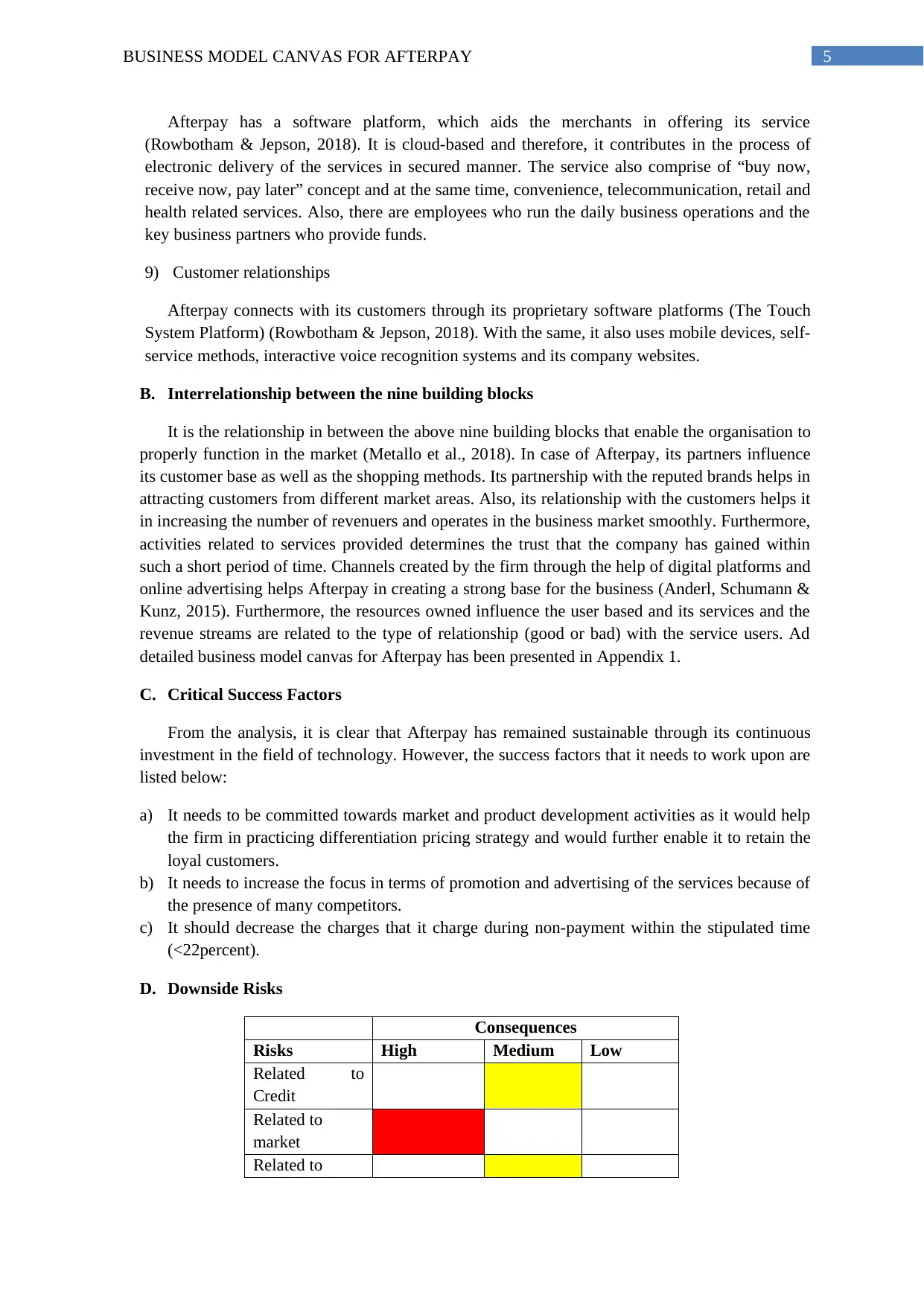
5BUSINESS MODEL CANVAS FOR AFTERPAY
Afterpay has a software platform, which aids the merchants in offering its service
(Rowbotham & Jepson, 2018). It is cloud-based and therefore, it contributes in the process of
electronic delivery of the services in secured manner. The service also comprise of “buy now,
receive now, pay later” concept and at the same time, convenience, telecommunication, retail and
health related services. Also, there are employees who run the daily business operations and the
key business partners who provide funds.
9) Customer relationships
Afterpay connects with its customers through its proprietary software platforms (The Touch
System Platform) (Rowbotham & Jepson, 2018). With the same, it also uses mobile devices, self-
service methods, interactive voice recognition systems and its company websites.
B. Interrelationship between the nine building blocks
It is the relationship in between the above nine building blocks that enable the organisation to
properly function in the market (Metallo et al., 2018). In case of Afterpay, its partners influence
its customer base as well as the shopping methods. Its partnership with the reputed brands helps in
attracting customers from different market areas. Also, its relationship with the customers helps it
in increasing the number of revenuers and operates in the business market smoothly. Furthermore,
activities related to services provided determines the trust that the company has gained within
such a short period of time. Channels created by the firm through the help of digital platforms and
online advertising helps Afterpay in creating a strong base for the business (Anderl, Schumann &
Kunz, 2015). Furthermore, the resources owned influence the user based and its services and the
revenue streams are related to the type of relationship (good or bad) with the service users. Ad
detailed business model canvas for Afterpay has been presented in Appendix 1.
C. Critical Success Factors
From the analysis, it is clear that Afterpay has remained sustainable through its continuous
investment in the field of technology. However, the success factors that it needs to work upon are
listed below:
a) It needs to be committed towards market and product development activities as it would help
the firm in practicing differentiation pricing strategy and would further enable it to retain the
loyal customers.
b) It needs to increase the focus in terms of promotion and advertising of the services because of
the presence of many competitors.
c) It should decrease the charges that it charge during non-payment within the stipulated time
(<22percent).
D. Downside Risks
Consequences
Risks High Medium Low
Related to
Credit
Related to
market
Related to
Afterpay has a software platform, which aids the merchants in offering its service
(Rowbotham & Jepson, 2018). It is cloud-based and therefore, it contributes in the process of
electronic delivery of the services in secured manner. The service also comprise of “buy now,
receive now, pay later” concept and at the same time, convenience, telecommunication, retail and
health related services. Also, there are employees who run the daily business operations and the
key business partners who provide funds.
9) Customer relationships
Afterpay connects with its customers through its proprietary software platforms (The Touch
System Platform) (Rowbotham & Jepson, 2018). With the same, it also uses mobile devices, self-
service methods, interactive voice recognition systems and its company websites.
B. Interrelationship between the nine building blocks
It is the relationship in between the above nine building blocks that enable the organisation to
properly function in the market (Metallo et al., 2018). In case of Afterpay, its partners influence
its customer base as well as the shopping methods. Its partnership with the reputed brands helps in
attracting customers from different market areas. Also, its relationship with the customers helps it
in increasing the number of revenuers and operates in the business market smoothly. Furthermore,
activities related to services provided determines the trust that the company has gained within
such a short period of time. Channels created by the firm through the help of digital platforms and
online advertising helps Afterpay in creating a strong base for the business (Anderl, Schumann &
Kunz, 2015). Furthermore, the resources owned influence the user based and its services and the
revenue streams are related to the type of relationship (good or bad) with the service users. Ad
detailed business model canvas for Afterpay has been presented in Appendix 1.
C. Critical Success Factors
From the analysis, it is clear that Afterpay has remained sustainable through its continuous
investment in the field of technology. However, the success factors that it needs to work upon are
listed below:
a) It needs to be committed towards market and product development activities as it would help
the firm in practicing differentiation pricing strategy and would further enable it to retain the
loyal customers.
b) It needs to increase the focus in terms of promotion and advertising of the services because of
the presence of many competitors.
c) It should decrease the charges that it charge during non-payment within the stipulated time
(<22percent).
D. Downside Risks
Consequences
Risks High Medium Low
Related to
Credit
Related to
market
Related to
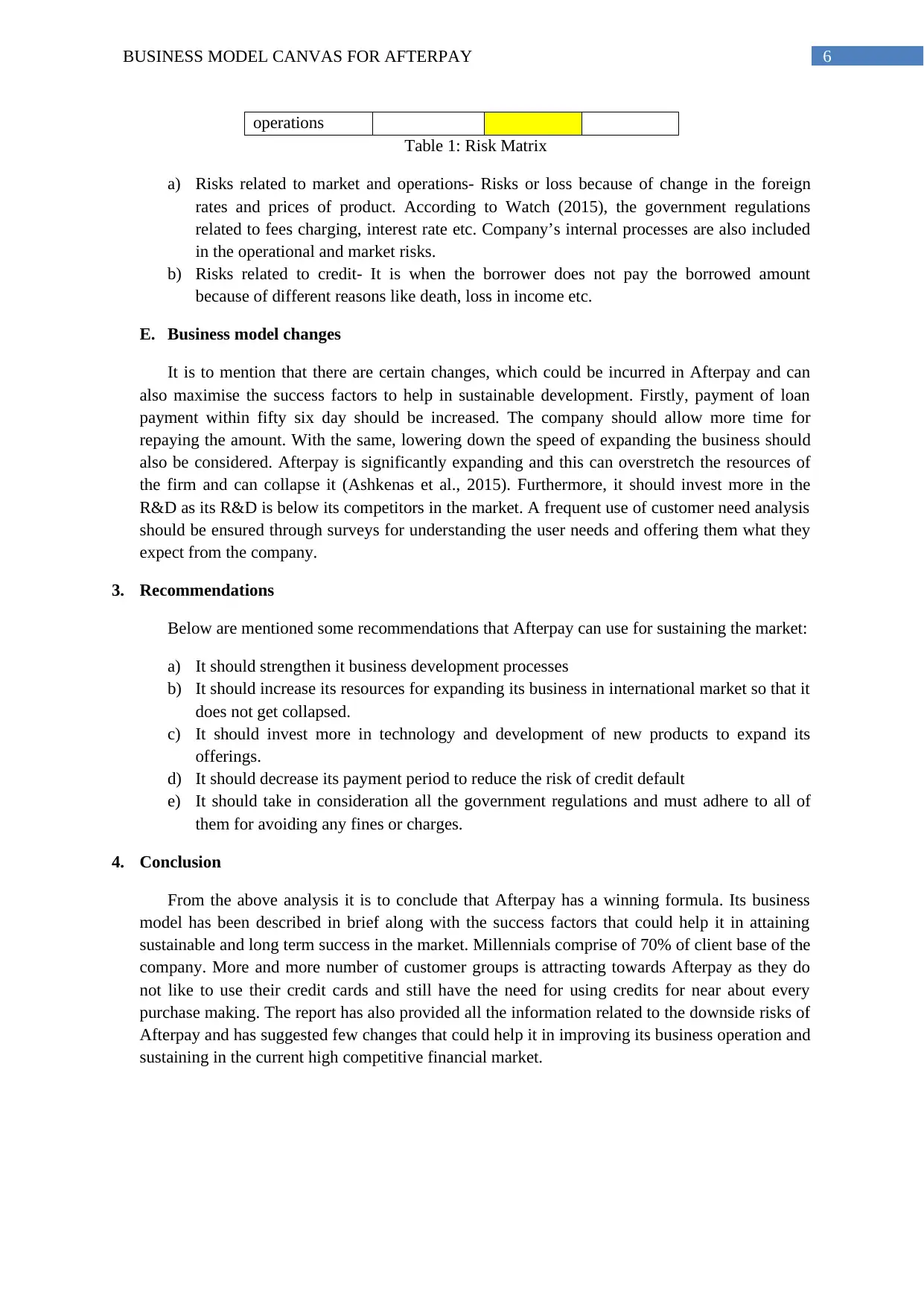
6BUSINESS MODEL CANVAS FOR AFTERPAY
operations
Table 1: Risk Matrix
a) Risks related to market and operations- Risks or loss because of change in the foreign
rates and prices of product. According to Watch (2015), the government regulations
related to fees charging, interest rate etc. Company’s internal processes are also included
in the operational and market risks.
b) Risks related to credit- It is when the borrower does not pay the borrowed amount
because of different reasons like death, loss in income etc.
E. Business model changes
It is to mention that there are certain changes, which could be incurred in Afterpay and can
also maximise the success factors to help in sustainable development. Firstly, payment of loan
payment within fifty six day should be increased. The company should allow more time for
repaying the amount. With the same, lowering down the speed of expanding the business should
also be considered. Afterpay is significantly expanding and this can overstretch the resources of
the firm and can collapse it (Ashkenas et al., 2015). Furthermore, it should invest more in the
R&D as its R&D is below its competitors in the market. A frequent use of customer need analysis
should be ensured through surveys for understanding the user needs and offering them what they
expect from the company.
3. Recommendations
Below are mentioned some recommendations that Afterpay can use for sustaining the market:
a) It should strengthen it business development processes
b) It should increase its resources for expanding its business in international market so that it
does not get collapsed.
c) It should invest more in technology and development of new products to expand its
offerings.
d) It should decrease its payment period to reduce the risk of credit default
e) It should take in consideration all the government regulations and must adhere to all of
them for avoiding any fines or charges.
4. Conclusion
From the above analysis it is to conclude that Afterpay has a winning formula. Its business
model has been described in brief along with the success factors that could help it in attaining
sustainable and long term success in the market. Millennials comprise of 70% of client base of the
company. More and more number of customer groups is attracting towards Afterpay as they do
not like to use their credit cards and still have the need for using credits for near about every
purchase making. The report has also provided all the information related to the downside risks of
Afterpay and has suggested few changes that could help it in improving its business operation and
sustaining in the current high competitive financial market.
operations
Table 1: Risk Matrix
a) Risks related to market and operations- Risks or loss because of change in the foreign
rates and prices of product. According to Watch (2015), the government regulations
related to fees charging, interest rate etc. Company’s internal processes are also included
in the operational and market risks.
b) Risks related to credit- It is when the borrower does not pay the borrowed amount
because of different reasons like death, loss in income etc.
E. Business model changes
It is to mention that there are certain changes, which could be incurred in Afterpay and can
also maximise the success factors to help in sustainable development. Firstly, payment of loan
payment within fifty six day should be increased. The company should allow more time for
repaying the amount. With the same, lowering down the speed of expanding the business should
also be considered. Afterpay is significantly expanding and this can overstretch the resources of
the firm and can collapse it (Ashkenas et al., 2015). Furthermore, it should invest more in the
R&D as its R&D is below its competitors in the market. A frequent use of customer need analysis
should be ensured through surveys for understanding the user needs and offering them what they
expect from the company.
3. Recommendations
Below are mentioned some recommendations that Afterpay can use for sustaining the market:
a) It should strengthen it business development processes
b) It should increase its resources for expanding its business in international market so that it
does not get collapsed.
c) It should invest more in technology and development of new products to expand its
offerings.
d) It should decrease its payment period to reduce the risk of credit default
e) It should take in consideration all the government regulations and must adhere to all of
them for avoiding any fines or charges.
4. Conclusion
From the above analysis it is to conclude that Afterpay has a winning formula. Its business
model has been described in brief along with the success factors that could help it in attaining
sustainable and long term success in the market. Millennials comprise of 70% of client base of the
company. More and more number of customer groups is attracting towards Afterpay as they do
not like to use their credit cards and still have the need for using credits for near about every
purchase making. The report has also provided all the information related to the downside risks of
Afterpay and has suggested few changes that could help it in improving its business operation and
sustaining in the current high competitive financial market.
Paraphrase This Document
Need a fresh take? Get an instant paraphrase of this document with our AI Paraphraser
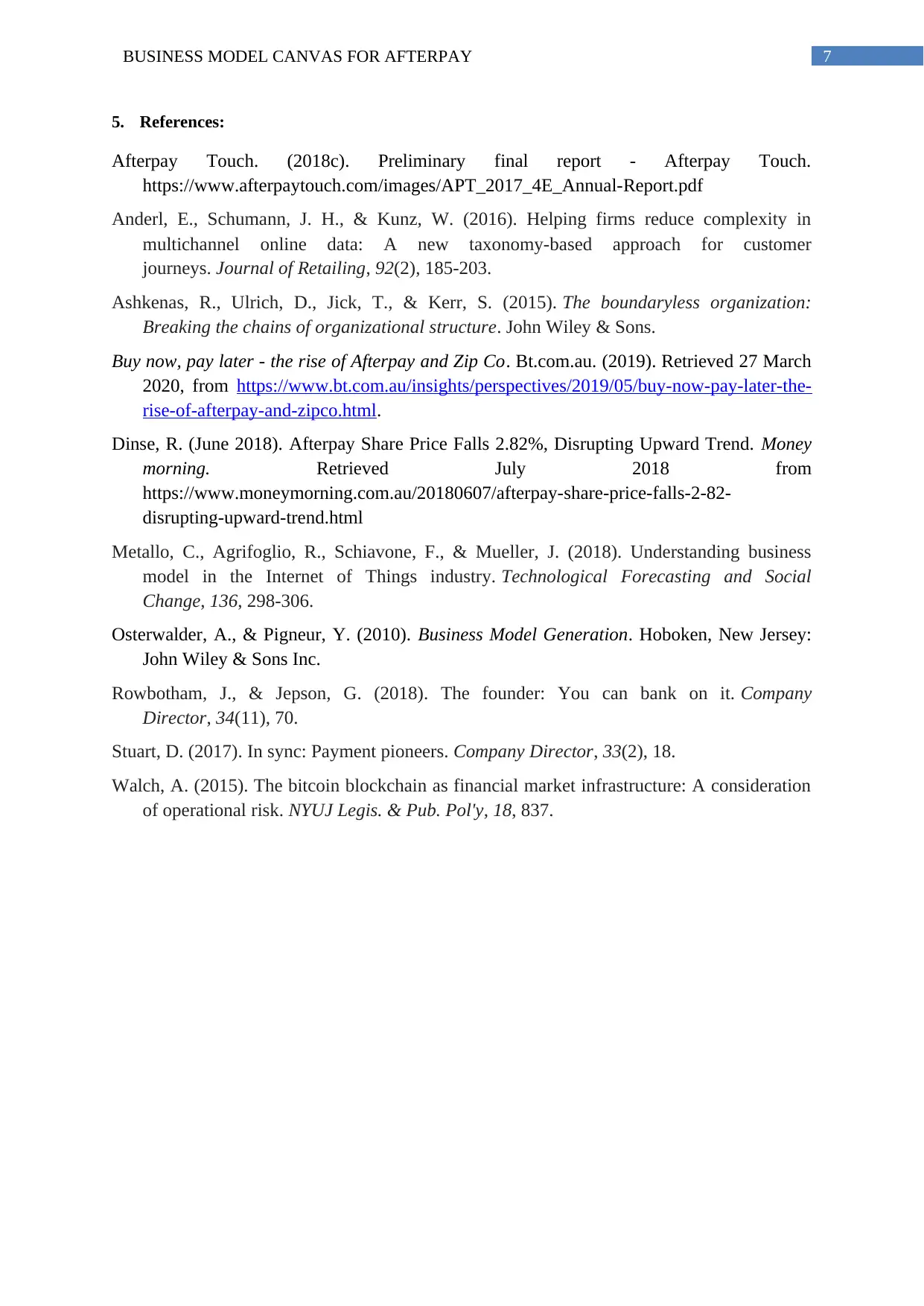
7BUSINESS MODEL CANVAS FOR AFTERPAY
5. References:
Afterpay Touch. (2018c). Preliminary final report - Afterpay Touch.
https://www.afterpaytouch.com/images/APT_2017_4E_Annual-Report.pdf
Anderl, E., Schumann, J. H., & Kunz, W. (2016). Helping firms reduce complexity in
multichannel online data: A new taxonomy-based approach for customer
journeys. Journal of Retailing, 92(2), 185-203.
Ashkenas, R., Ulrich, D., Jick, T., & Kerr, S. (2015). The boundaryless organization:
Breaking the chains of organizational structure. John Wiley & Sons.
Buy now, pay later - the rise of Afterpay and Zip Co. Bt.com.au. (2019). Retrieved 27 March
2020, from https://www.bt.com.au/insights/perspectives/2019/05/buy-now-pay-later-the-
rise-of-afterpay-and-zipco.html.
Dinse, R. (June 2018). Afterpay Share Price Falls 2.82%, Disrupting Upward Trend. Money
morning. Retrieved July 2018 from
https://www.moneymorning.com.au/20180607/afterpay-share-price-falls-2-82-
disrupting-upward-trend.html
Metallo, C., Agrifoglio, R., Schiavone, F., & Mueller, J. (2018). Understanding business
model in the Internet of Things industry. Technological Forecasting and Social
Change, 136, 298-306.
Osterwalder, A., & Pigneur, Y. (2010). Business Model Generation. Hoboken, New Jersey:
John Wiley & Sons Inc.
Rowbotham, J., & Jepson, G. (2018). The founder: You can bank on it. Company
Director, 34(11), 70.
Stuart, D. (2017). In sync: Payment pioneers. Company Director, 33(2), 18.
Walch, A. (2015). The bitcoin blockchain as financial market infrastructure: A consideration
of operational risk. NYUJ Legis. & Pub. Pol'y, 18, 837.
5. References:
Afterpay Touch. (2018c). Preliminary final report - Afterpay Touch.
https://www.afterpaytouch.com/images/APT_2017_4E_Annual-Report.pdf
Anderl, E., Schumann, J. H., & Kunz, W. (2016). Helping firms reduce complexity in
multichannel online data: A new taxonomy-based approach for customer
journeys. Journal of Retailing, 92(2), 185-203.
Ashkenas, R., Ulrich, D., Jick, T., & Kerr, S. (2015). The boundaryless organization:
Breaking the chains of organizational structure. John Wiley & Sons.
Buy now, pay later - the rise of Afterpay and Zip Co. Bt.com.au. (2019). Retrieved 27 March
2020, from https://www.bt.com.au/insights/perspectives/2019/05/buy-now-pay-later-the-
rise-of-afterpay-and-zipco.html.
Dinse, R. (June 2018). Afterpay Share Price Falls 2.82%, Disrupting Upward Trend. Money
morning. Retrieved July 2018 from
https://www.moneymorning.com.au/20180607/afterpay-share-price-falls-2-82-
disrupting-upward-trend.html
Metallo, C., Agrifoglio, R., Schiavone, F., & Mueller, J. (2018). Understanding business
model in the Internet of Things industry. Technological Forecasting and Social
Change, 136, 298-306.
Osterwalder, A., & Pigneur, Y. (2010). Business Model Generation. Hoboken, New Jersey:
John Wiley & Sons Inc.
Rowbotham, J., & Jepson, G. (2018). The founder: You can bank on it. Company
Director, 34(11), 70.
Stuart, D. (2017). In sync: Payment pioneers. Company Director, 33(2), 18.
Walch, A. (2015). The bitcoin blockchain as financial market infrastructure: A consideration
of operational risk. NYUJ Legis. & Pub. Pol'y, 18, 837.
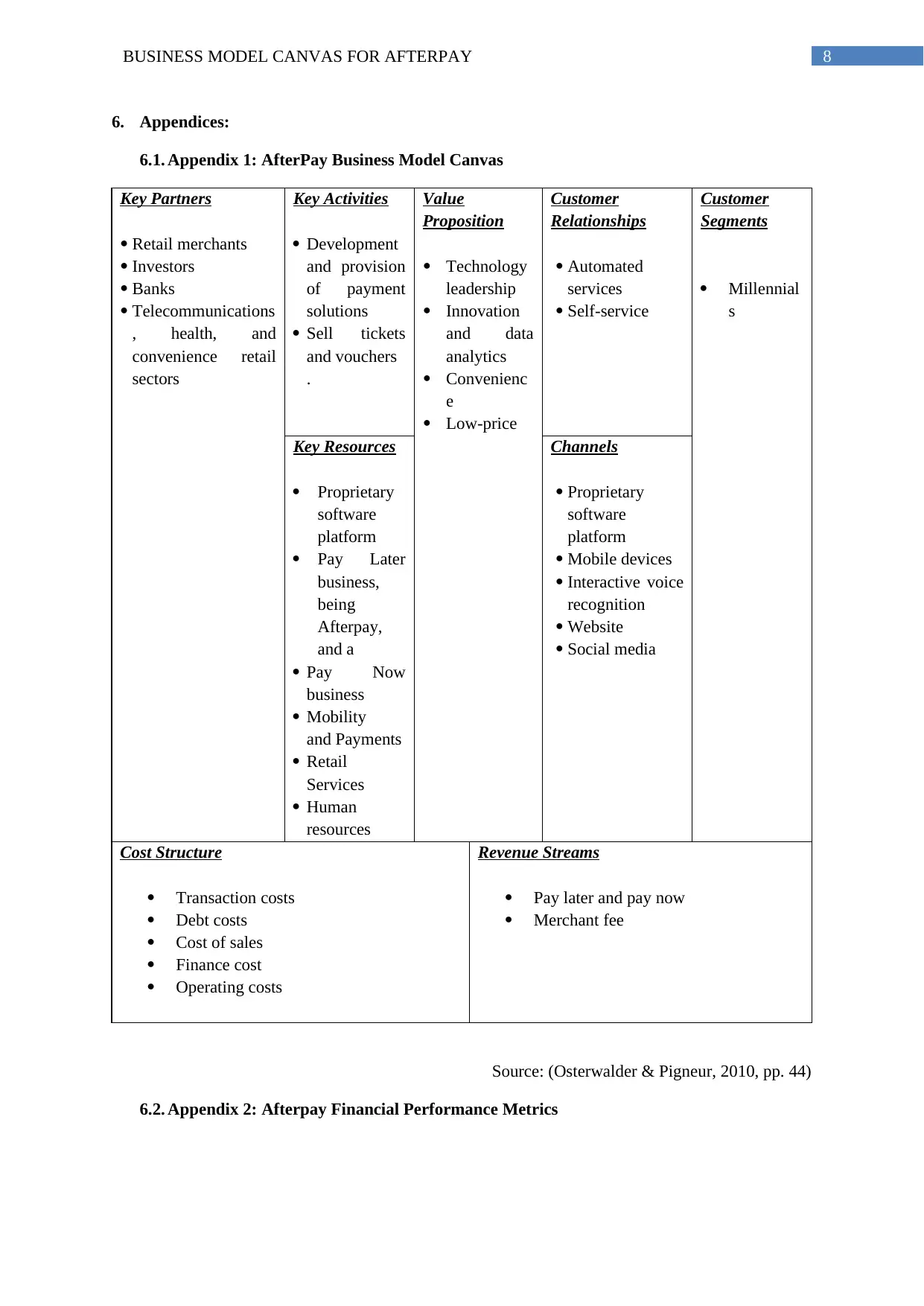
8BUSINESS MODEL CANVAS FOR AFTERPAY
6. Appendices:
6.1. Appendix 1: AfterPay Business Model Canvas
Key Partners
Retail merchants
Investors
Banks
Telecommunications
, health, and
convenience retail
sectors
Key Activities
Development
and provision
of payment
solutions
Sell tickets
and vouchers
.
Value
Proposition
Technology
leadership
Innovation
and data
analytics
Convenienc
e
Low-price
Customer
Relationships
Automated
services
Self-service
Customer
Segments
Millennial
s
Key Resources
Proprietary
software
platform
Pay Later
business,
being
Afterpay,
and a
Pay Now
business
Mobility
and Payments
Retail
Services
Human
resources
Channels
Proprietary
software
platform
Mobile devices
Interactive voice
recognition
Website
Social media
Cost Structure
Transaction costs
Debt costs
Cost of sales
Finance cost
Operating costs
Revenue Streams
Pay later and pay now
Merchant fee
Source: (Osterwalder & Pigneur, 2010, pp. 44)
6.2. Appendix 2: Afterpay Financial Performance Metrics
6. Appendices:
6.1. Appendix 1: AfterPay Business Model Canvas
Key Partners
Retail merchants
Investors
Banks
Telecommunications
, health, and
convenience retail
sectors
Key Activities
Development
and provision
of payment
solutions
Sell tickets
and vouchers
.
Value
Proposition
Technology
leadership
Innovation
and data
analytics
Convenienc
e
Low-price
Customer
Relationships
Automated
services
Self-service
Customer
Segments
Millennial
s
Key Resources
Proprietary
software
platform
Pay Later
business,
being
Afterpay,
and a
Pay Now
business
Mobility
and Payments
Retail
Services
Human
resources
Channels
Proprietary
software
platform
Mobile devices
Interactive voice
recognition
Website
Social media
Cost Structure
Transaction costs
Debt costs
Cost of sales
Finance cost
Operating costs
Revenue Streams
Pay later and pay now
Merchant fee
Source: (Osterwalder & Pigneur, 2010, pp. 44)
6.2. Appendix 2: Afterpay Financial Performance Metrics
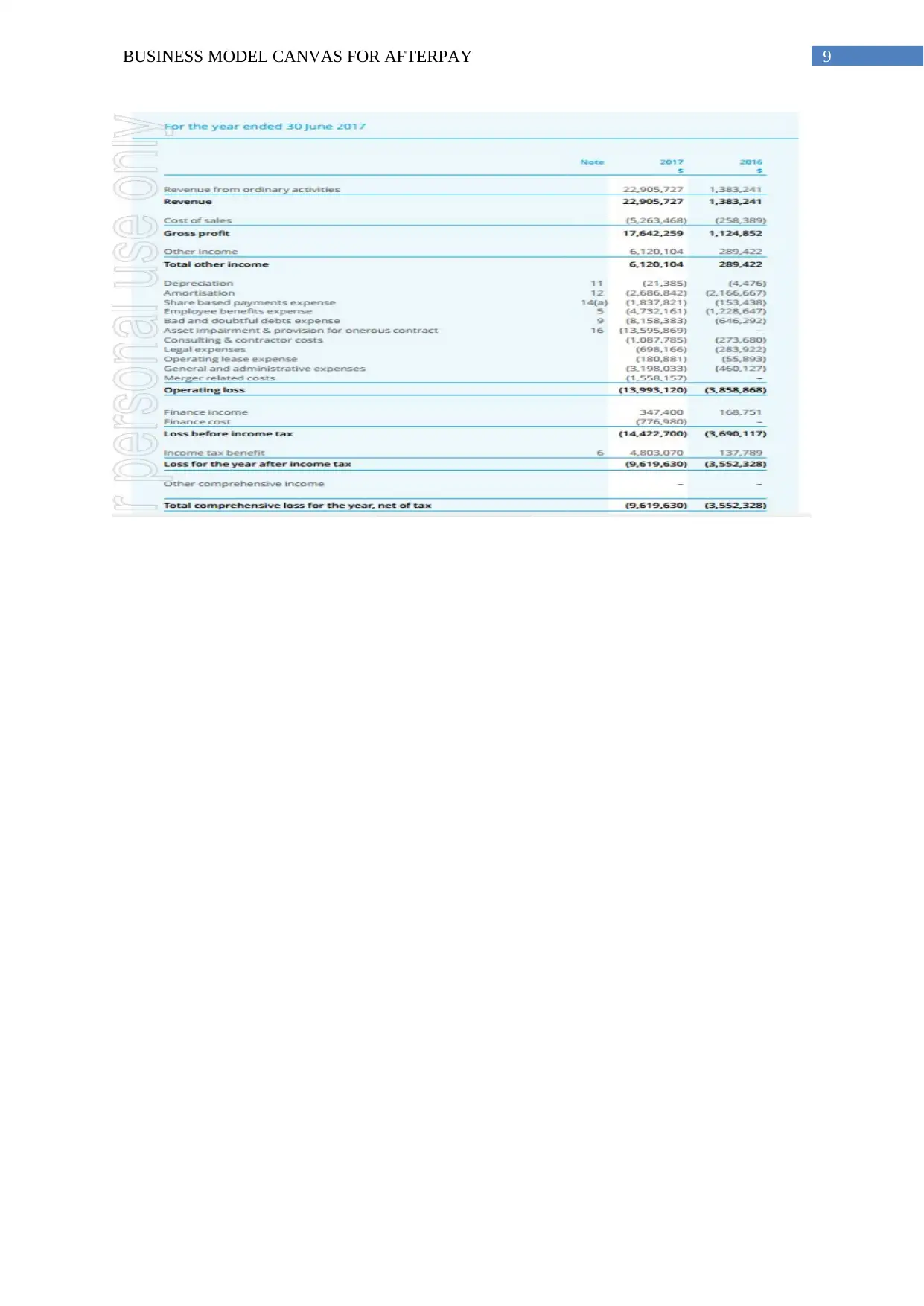
9BUSINESS MODEL CANVAS FOR AFTERPAY
1 out of 10
Related Documents
Your All-in-One AI-Powered Toolkit for Academic Success.
+13062052269
info@desklib.com
Available 24*7 on WhatsApp / Email
![[object Object]](/_next/static/media/star-bottom.7253800d.svg)
Unlock your academic potential
© 2024 | Zucol Services PVT LTD | All rights reserved.





